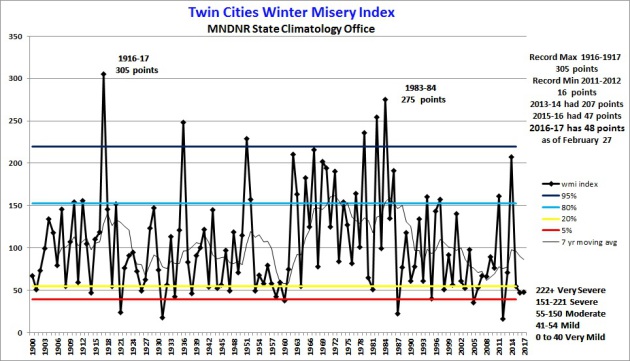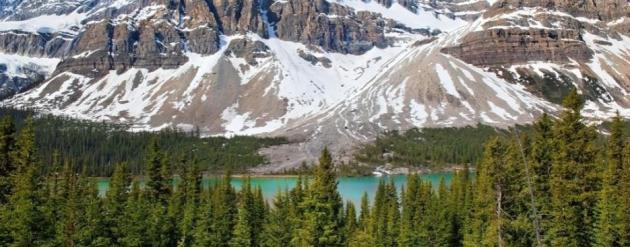44 F. high temperature in the Twin Cities Monday.
33 F. average high on February 27.
58 F. maximum temperature on February 27, 2016.
February 28, 1981: Ice is out on Lake Minnetonka. Boats are enjoying the early thaw.
Ditto: Odds Favor Warmer Than Average Into Spring"The
future is an enigma wrapped in a riddle." Wait, Warren Beatty just handed me
an envelope with the Spring 2017 Outlook - I'm very excited to share the
news with you and other members of the Academy.
NOAA predicts
warmer and wetter from March thru May, which, when you really think
about it, isn't much of a stretch. Meteorologists refer to
"persistence", which is a fancy way of saying "go with the flow". The
first best-guess is a continuation of the current pattern. Which has
been consistently milder than average.
February is over 10F.
warmer than normal in the Twin Cities; the 6th or 7th warmest on record.
According to the Minnesota DNR we didn't add any points to the "Winter
Misery Index" this month. Heck, the metro picked up 3 tenths of an inch
of snow.
Welcome to Shreveport!
Rain falls today with highs
in the low 40s. March comes in like a Star Nosed Mole tomorrow, with
scrappy clouds and a cooler wind. Weekend temperatures may top 50F, even
a shot at a few 60s late next week!
I'm keeping the driveway
stakes in, just in case March lives up to its reputation. The ECMWF
hints at slushy snow early next week.
Map credit:
NOAA CPC
(Climate Prediction Center) is forecasting milder than average for much
of the USA over the next 3 months, with a wet bias from the Pacific
Northwest to the Great Lakes. Place your bets.
Not Much Misery in February.
No surprise - we didn't add any points to the Winter Misery Index this
month. That's how mild (and snow-free) it's been. Details via the
Minnesota DNR: "...
As of February 27, 2017 the WMI for the 2016-17 winter is at 48 points:
23 points for cold, 25 points for snow. This is enough for this winter
to be in the "mild" category. Seven more points are needed for this
winter to be categorized as "moderate." February 2017 is poised to have no
Winter Misery Index points. The only other time there has been no WMI
points in February was 1964. There's been only .3 (three tenths) of an
inch of snow for February 2017 and if no more snow falls by the end of
the month, this would tie the least snowiest February on record.
February 1894 also had only .3 (three tenths) of an inch of snow. There
has also been no minimum temperature of zero or colder in February 2017
as well..."

Enhanced Severe Threat.
NOAA SPC
has put much of the Ohio Valley and Mid South under a slight to
enhanced risk of severe storms today and Wednesday, including large hail
and a few isolated tornadoes. Based on a persistently strong
subtropical jet stream and wind shear profiles favorable for tornadic
supercell T-storms I have a hunch it's going to be a much busier spring
for twisters across the USA. I hope I'm wrong.
 84-Hour Outlook
84-Hour Outlook.
NOAA's NAM guidance shows numerous showers and T-storms breaking out
from the Great Lakes to the Gulf Coast; most severe across the Mid South
later today and Wednesday. Rain today ends as a little slush tonight
and Wednesday across Minnesota and Wisconsin, while the Pacific
Northwest braces for more heavy rain and snow in the coming days. The
map looks like something out of the third or fourth week of March.
Animation: Tropicaltidbits.com.
Consistently 10 Degrees Above Average.
Normal highs now are in the mid-30s, but ECMWF (European) model
guidance continues to show a run of 40s, maybe 50s by the weekend.
Although the ensemble product above shows upper 40s late next week some
of the guidance I'm seeing suggests close to 60F. We'll see. Twin Cities
numbers: WeatherBell.
 Snowfall Potential Into Next Monday.
Snowfall Potential Into Next Monday.
That great snowy spigot in the sky just doesn't want to shut off, from
the Rockies of New Mexico and Colorado to the Cascade Range in Oregon
and Washington state, where GFS guidance prints out some 2-4 FOOT
snowfall amounts over the next 6 days. Yes, there will be water in the
Colorado River this year.
Mellow March.
A weak omega block is forecast to set up within 2 weeks, cold storms
anchored over the Canadian Maritimes and Pacific Northwest, a relatively
mild, dry, benign ridge of high pressure straddling the central USA. If
this 500mb forecast verifies it would imply 50s as far north as the
Twin Cities, Milwaukee and Detroit, with a run of 60s Denver to St.
Louis to Washington D.C.

March Comes In Like an Iguana East of the Mississippi.
OK. the whole lamb/lion thing just didn't work - I had to come up with a
warm weather animal. And who doesn't love iguanas? Temperatures on
Wednesday are forecast to be 20F above average (again) across much of
the eastern USA - more records will fall.
Map credit:
Climate Reanalyzer.

Spring in February: Why Was This Winter so Warm?
UMN Experts Weigh In. Many people want a simple, TV-soundbite answer,
when the reality is more complex. But CO2 at 408 ppm may be a big factor
in the ongoing warming trend. Here's an excerpt from
Minnesota Daily: "
Though
February has been a record-breaking warm month for Minnesota, experts
say the temperatures can’t be solely attributed to climate change.
Minnesota is leading the continental United States in how quickly it’s
warming. But experts say warm temperatures this winter can be attributed
to a couple main factors. Historically, there have been random bursts
of warm weather during Minnesota winters. But climate change has
amplified these occasional spikes, including this year’s, said Kenny
Blumenfeld, a Minnesota Department of Natural Resources climatologist.
“There have been previous warm streaks in February but because of a
long-term warming trend, this year had a little extra oomph,” Blumenfeld
said. This long-term warming trend has sped up during the past 50
years, which Blumenfeld attributes to greenhouse gases being unable to
escape in the atmosphere..."
Daily Record Highs Across the USA.
So far this month records for warm weather records outnumber cold
weather records, 9,544 to 137. Over the last year warm weather records
have outnumbered cold weather records 15,723 to 2,636. One year does
not a trend make, but keep in mind the 10 warmest years on record have
occurred since 1998. Data courtesy of
NOAA NCDC.
Scores of Northeastern U.S. Cities Just Had Their Warmest February Ever Recorded. Jason Samenow has details at
Capital Weather Gang: "...
The
record February highs set in the Northeast mark a continuation of
historic warmth that spread across the eastern two-thirds of the country
and into Canada over the course of the week. Burlington, Vt.; Albany,
N.Y.; and Toronto set all-time February record highs on Thursday.
On Wednesday, the Wisconsin cities of Milwaukee, Madison and Green Bay
accomplished the feat. All of this record-breaking warmth caps off an
abnormally warm month for much of the Lower 48. Incredibly, the National
Oceanic Administration has logged 4,492 record-high temperatures
compared with just 29 record lows — which equates to a quite lopsided
ratio of 155 to 1."
Map credit: "
Temperature difference from normal at 1 p.m. Friday analyzed by GFS model."


 Snow Dump in Iceland
Snow Dump in Iceland. Check out some of the photos of the recent heavy snow event in Reykjavik at
The Iceland Monitor: "
Icelandic
photographer Gunnar Freyr woke up to the sound of a tree breaking in
his garden and saw the heavy snowfall coming down. He grabbed his
camera and ventured into the city centre to capture these fantastic
photos of a magical night. Snow depth was
measured at 51 cm at 9 am this morning in the capital which breaks the
record of 48 cm in February in 1952. Only once has this been exceeded,
in January of 1937 when snow was 55 cm..."
Photo credit: "People had some hard work in store for them on Sunday when it came to retrieving their cars."
Photo/Gunnar Freyr.

A Part-Time National Weather Service?
If there's even an inkling of truth to this post it spells trouble, not
just for National Weather Service employees, but for American
consumers. Because severe weather outbreaks aren't "part-time",wild
weather often strikes during the overnight hours, and there's no way to
adequately replace the local institutional memory and forecast skill of
local WFOs with a few larger, regional (hub) offices. Let's hope this
turns out to be a false alarm. But just in case - you might want to pick
up the phone and call your state and national representatives. We need to be reinvesting in our National Weather Service, not looking for areas to cut. Here's an excerpt from The National Weather Service Employees Organization: "On
the same day that National Weather Service Director Dr. Uccellini tells
employees, “part timing of the offices is off the table,” presentation
slides showing distinct plans to part time offices are distributed at
NCEPs annual planning meeting. NWSEO has obtained a 37 slide PowerPoint presentation made to NCEP managers on February 14, 2017
at NCEP’s Annual Operating Plan meeting. The presentation was made by
the Director of the Office of Programming and Planning for Service
Delivery, who is tasked with execution of the Evolve NWS plans. Only the
first 22 slides were presented at the meeting. Slides 23-37, which were
distributed but not shown, highlight plans to reduce staff and part
time offices.
According to this PowerPoint, developed and
partially presented by the NWS’s Project Management Office, only 37 of
the 116 WFOs in the continental U.S. will be operating 24/7/365 by FY
19. Also on February 14, the same date as the NCEP annual
meeting, NWS Director Dr. Uccellini assured employees, “the part timing
of the offices is off the table” at a Fireside Chat webinar with the
Cheyenne, Wyoming and Shreveport, Louisiana Weather Forecast Offices.
This follows his statements at the January 2017 AMS meeting in Seattle,
Washington that there will be no “part timing of Forecast Offices....”
The Powerpoint in question is
here.
 Flood Insurance: Does Your Excuse Hold Water?
Flood Insurance: Does Your Excuse Hold Water? With flash flooding on the rise it might be wise to review your coverage. Here's an excerpt from
The Orlando Sentinel: "
We
know the old saying: when it rains, it pours… and when it pours, it
floods. With winter snow storms coming to an end, the threat of flooding
increases as the snow begins to melt and the rivers and creeks begin to
swell. It’s easy to forget about how powerfully destructive water can
be. In fact, nine out of 10 natural disasters include flood, making it
the number one disaster in the United States according to the National
Flood Insurance Program (NFIP). However, only 15 percent of homeowners
have flood insurance. From 2006 to 2015, total flood claims cost more
than $1.9 billion per year and the average claim was more than $46,000
during that time..." (Fort Lauderdale flood file photo: NOAA).

 Saudi Arabia to Curb Oil Use With $50 Billion Renewable Energy Plan
Saudi Arabia to Curb Oil Use With $50 Billion Renewable Energy Plan. Here's a clip from
Good News Network: "
Saudi
Arabia, the nation ranked as one of the world’s top crude oil
exporters, has launched a $50 billion initiative to phase out fossil
fuels in favor of renewable energy. The country plans on harnessing 10
gigawatts of renewable energy by 2023 by constructing several wind and
solar plants throughout the nation. Saudi Arabia plans on completing the
initiative with 700 gigawatts. The initiative will not only be
economically beneficial for the nation’s residents, but will also help
steer Saudi Arabia’s main federal income away from crude oil as well as
help the country meet worldwide sustainable energy goals..."
Photo credit: D.H. Parks, CC.
Statement on Bipartisan Push for an Increased Renewable Energy Standard. Here's are excerpts from a press release at
Fresh Energy: "
Today,
lawmakers from both parties were announced as chief authors of a bill
to increase Minnesota’s Renewable Energy Standard to 50 percent by 2030.
The legislation would update Minnesota’s existing Renewable Energy
Standard, which has lowered energy costs, grown clean energy jobs, and
increased tax payments to local communities across the
state...Investment in wind and solar has helped create hundreds of
businesses that employ thousands of Minnesotans in family-supporting
jobs and pay millions in tax payments to communities across the state.
Fresh Energy is thrilled to see lawmakers on both sides of the aisle
pushing for policy that will encourage more investment in clean energy.”
Photo credit: "
Rep.
Joe Schomacker (top left), Sen. Karin Housley (top right), Sen. Nick
Frentz (bottom left), Rep. Erin Maye Quade (bottom right)."
50 by '30 Renewable Energy Standard for Minnesota. A (pdf) Fact Sheet is
here.
Buying an Electric Vehicle? A Growing List of States Will Charge You Extra Yearly Fees.
Vox has an update: "...
At the end of 2015, the Department of Energy identified nine states that levy extra yearly fees on purchasers of EVs. Since then, Michigan added a fee, so the number now stands at 10. As the Sierra Club reports,
“since the start of 2017, six states (Indiana, South Carolina, Kansas,
Tennessee, New Hampshire, and Montana) have introduced legislation that
would require EV owners to pay a fee of up to $180 a year...”
Image credit:
EV fees. (Car & Driver)

Former Trump Aid Says Renewable Energy May Be Cut. TIME.com has more details: "
A former top aide
on energy issues for President Trump's transition speculated that the
Administration will cut research funding for wind and solar power and
redirect money to fossil fuels. Energy lobbyist Mike McKenna, who headed
Trump's Department of Energy transition team until late November, told
the West Virginia Coal Association that current funding allocations
favoring renewable energy would likely be changed. "The young people
have a word for it, it's not sustainable," he said, alluding to the
agency that crafts the President's budget. "If DOE doesn’t take care of
that on it’s own accord, the Office of Management and Budget almost
certainly will..." (File photo: Joe McNally, NatGeo).
No, Cell Phones Don't Cause Cancer. Probably. There is risk every time you fall out of bed in the morning, but is using a smart phone an acceptible risk?
WIRED reports: "...
A
lot of people were really concerned when they heard the United Nations
cancer agency has declared that cellphones might cause cancer,” says
Brawley. “But when you realize that lipstick, pickles, and styrofoam are
on that list, it puts it into a different perspective.” None of those
things are necessarily super high-risk—the IPRC designation just leaves
open the possibility that some carcinogenicity exists.
In other words, a dearth of data means that no one would conclude right
now that that cellphones cause cancer. “I think it’s an unsettled
question, it’s a legitimate question,” Brawley says. “I believe the
answer is no.” After all, he notes, brain tumor rates haven’t increased
over the last 40 years. “However, none of us can tell you what the 30 or
40 year experience of people using cellphones will be,” he adds,
“because we haven’t had cellphones that long...”
 Study Finds Cyclists 6 Times Healthier Than Other Commuters
Study Finds Cyclists 6 Times Healthier Than Other Commuters. Because it's harder to eat chips on a bike. Here's an excerpt from
Momentum Mag: "...
When
many people consider the health impacts of cycling, they think of the
sport-oriented form of cycling that involves long-distance, fast rides
and lycra, or at the very least a pair of sneakers and a workout shirt.
Casual commuter cycling is better for you than sitting in a car or on
the bus, sure, but it can’t be that much better, can it? A recent study
undertaken at Brunel University in London, England, found that English
people who regularly commute by bike are four times more likely than
other commuters to get the 150 minutes of moderate exercise per week
recommended by the World Health Organization. With its focus narrowed to
London rather than nationwide, bike commuters were six times more
likely to meet the recommended activity guidelines..."
Photo credit:
Kamyar Adl
Where to Find the World's Best Hometown Monsters.
Atlas Obscura has a hair-raising list: "...
Bigfoot is generally associated with the Pacific Northwest, with most sightings reported in Washington.
Ape Canyon was the site in which a group of miners came under attack by
a gang of wild “apemen” in 1924. According to the five miners, all of
whom survived the incident and seemed convinced of its facts, they were
asleep in their cabin when the assault started, and the beasts seemed
out for blood. The event was widely publicized and no logical
explanation was ever found. The Sasquatch mythos has caught many in its
spell. Refusing to accept claims that Bigfoot sightings are actually
black bears or intentional hoaxes, believers continue their search for
the hidden primate. California, Oregon, Washington and Canada are dotted with Sasquatch museums and research institutions for those who want to see footprints, photos, and other evidence..."
Photo credit:
"Ape Canyone, where miners were attacked by "apemen." Jordan/CC By-NC-SA 2.0

TODAY: Light rain, drizzle. Winds: N 8-13. High: 43
TUESDAY NIGHT: Leftover clouds and flurries, damp. Low: 26
WEDNESDAY: Scrappy clouds, few flurries. Winds: NW 8-13. High: 36
THURSDAY: More clouds than sun, brisk. Average for early March. Winds: N 8-13. Wake-up: 22. High: 33
FRIDAY: Sunny start, then clouds increase. Winds: S 10-15. Wake-up: 19. High: 38
SATURDAY: Partly sunny and milder. Winds: S 7-12. Wake-up: 30. High: 51
SUNDAY: Peeks of sun, more hints of April. Winds: S 8-13. Wake-up: 38. High: 56
MONDAY: Rain changes to snow, gusty and colder. Winds: NW 15-25. Wake-up: 40. high: 42 (falling)
Climate Stories....
How a Capitalist Should Tackle Climate Change. Ted Halstead has an Op-Ed at
Fortune: "...
In The Conservative Case For Carbon Dividends,
my co-authors James Baker, George Shultz, Henry Paulson, Martin
Feldstein, Gregory Mankiw, Tom Stephenson, Rob Walton and I propose a
distinctly capitalist solution to climate change. Capitalism is a
wonderful system, even though – like many operating systems – it suffers
from an occasional bug. The most significant is that market prices fail
to take social and environmental costs into account, which explains why
greenhouse gas emissions have reached dangerous levels. The obvious
remedy is taxing pollution. Indeed, our solution boils down to getting
the price signals right, and the government out of the way.Our statement
should put to rest several myths that impede a more ambitious and
coherent American climate response. First, it shows that Democrats have
no monopoly of concern about protecting our climate. Contrary to the
easy characterization of Republicans as climate deniers, many Republican
leaders take seriously the risk of climate change, and a good number
are looking for the right opportunity to orchestrate a collective
climate jailbreak..."
To Get Ahead, Corporate America Must Account for Climate Change. Here's an excerpt of an Op-Ed at
TheHill: "...
Thinking
ahead is a competitive advantage — companies that adapt to changing
markets will survive and prosper. Of course, many of America’s top
companies have global reach, producing and selling around the world. A
U.S. presidential administration that ignores climate change will be a
short-term blip. I recommend corporate America mostly ignore that blip
and continue to develop low-carbon technologies and production
processes. They will be competitive in the emerging clean energy market
that is taking hold globally. Eventually, American companies will
prosper domestically when science-based evidence undergirds policy
initiatives again. For the U.S. to be a haven for forward-looking
companies, it needs to lead on climate change, not deny that it is
happening..."

South Florida Continues Prep for Sea Level Rise. Here's the intro to a story at
SunSentinel: "
South
Florida is taking more steps to protect against climate change and the
rising seas that already are spilling over into neighborhoods. This
month, Broward County ordered that new flood maps be drawn using
predictions of higher waters, the latest in a series of steps taken from
Palm Beach County to the Keys. Fort Lauderdale raised the required
height of sea walls and the elevation of home sites; Delray Beach
added valves to keep salt water out of the city drainage system;
Broward County put a financing program in place for homeowners who want
to tap solar energy. That doesn’t mean Florida is all ready and set for
the ill effects of rising global temperatures. A nationally recognized
advocacy group that rated states on preparedness gave Florida a C- ..."
Photo credit: "
Flooding from seasonal king tides has worsened in Fort Lauderdale as a result of sea-level rise." (Joe Cavaretta/Sun-Sentinel)
For Some Arctic Plants, Spring Arrives Almost a Month Earlier. Here's an excerpt from
The New York Times: "
Every
spring, Arctic plants rely on cues from the environment — like warmer
weather, longer days and shrinking ice sheets — to tell them when they
should awaken from winter’s slumber. But as the climate warms, these
plants are getting mixed signals about when to rouse. In a new paper
published in Biology Letters, researchers detail findings from a
12-year study of when plant species in the low Arctic region of
Greenland first bud in the spring. Timing varied from plant to plant,
but one speedy sedge species — a flowering, grasslike herb — stirred a
full 26 days earlier than it did a decade ago. The change corresponds to
nearly an entire growing season, and breaks the record for the greatest
shift in spring-bloom timing that the scientists have observed in the
Arctic..." (File photo credit: Arctic Journal).
 St. Paul Launches Climate Action Plan Effort to Become Carbon Neutral.
St. Paul Launches Climate Action Plan Effort to Become Carbon Neutral. Here's an excerpt from
Star Tribune: "
To
offset St. Paul's total annual greenhouse gas emissions, the city would
have to install 985 wind turbines. Or it could preserve more than
31,086 acres of forests or somehow prevent 575,901 homes from using
electricity for a year. But adding a turbine every few blocks or having
hundreds of thousands of people go off the grid probably is not the
answer, so the city is launching an effort to come up with a Climate
Action Plan that provides a feasible path to reduce pollution. St.
Paul's goal is to be carbon neutral by 2050, completely offsetting
emissions so there would be no net release of carbon dioxide into the
atmosphere. It is one of 633 communities across the world that agreed,
as part of a compact of mayors, to develop plans to address climate
change..."
File photo:
St. Paul Chamber of Commerce.








No comments:
Post a Comment